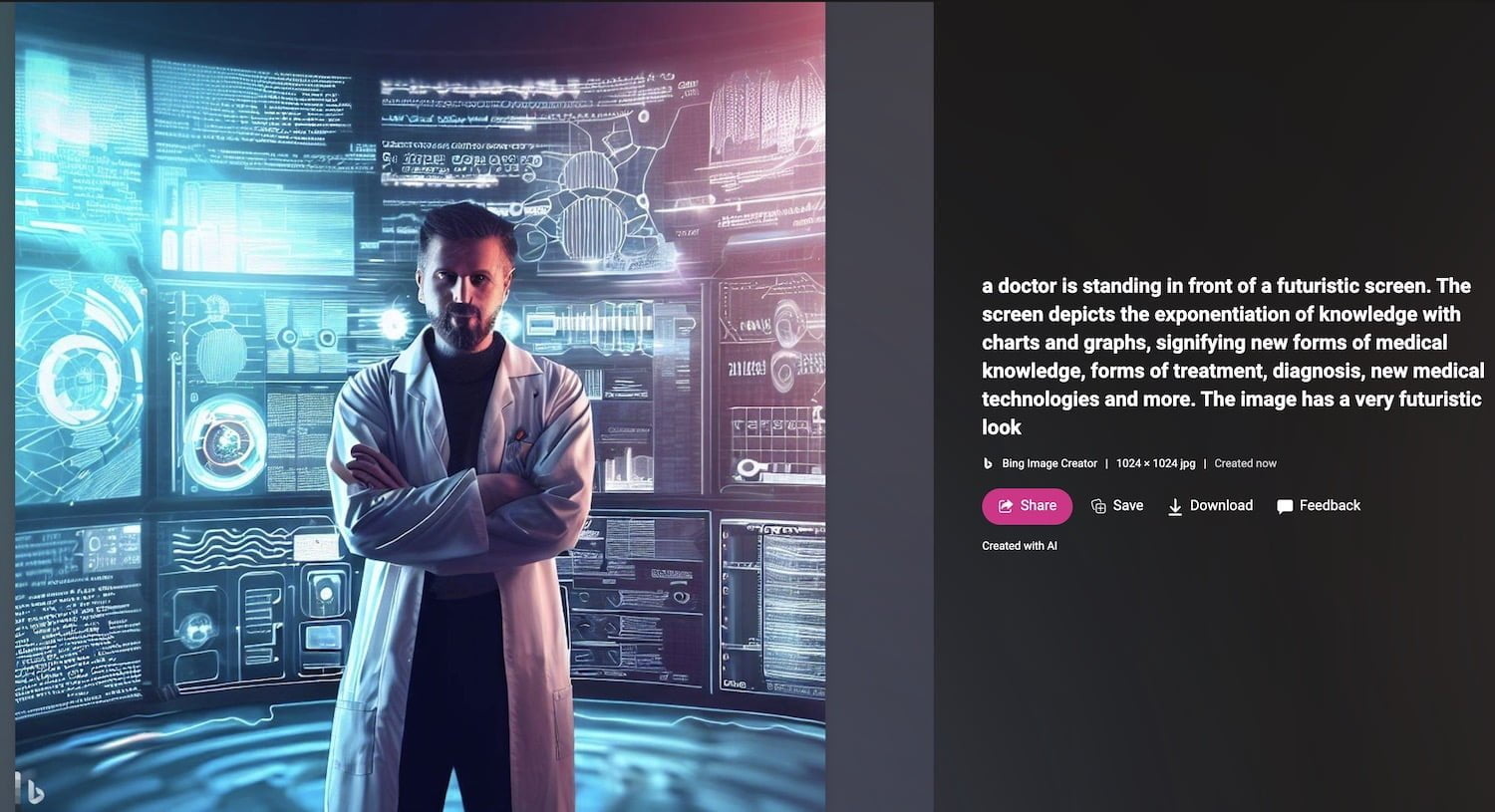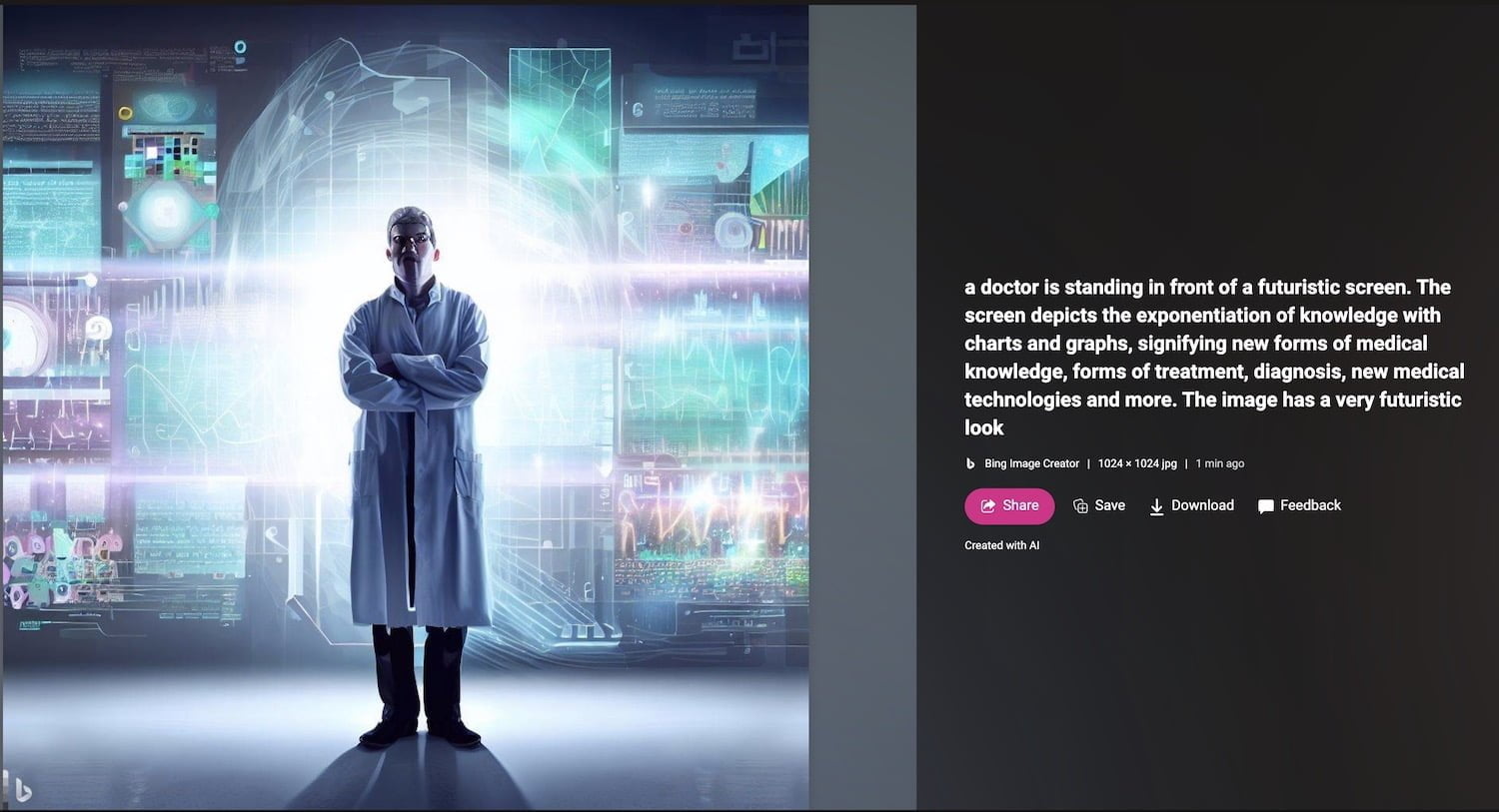ChatGPT, Stable Diffusion and Midjourney, and all the other technology that is in the press these days are massively disruptive – the future of the way we search and interact with information is set to change in massive ways. And yet, with all the attention on that, few folks are thinking of the other big issues that have already been unfolding in every industry and profession as AI continues its relentless march forward.

Over my 30+ year career as a futurist, I have spent a lot of time in CEO leadership meetings and as the keynote speaker at conferences and events speaking about the acceleration of knowledge.
We live in the era of the acceleration of all knowledge. These are the trends that define the future:
- Rapid knowledge obsolescence
- Rapid knowledge emergence
- The disappearance of existing careers due to 1)
- The rapid emergence of new careers due to 2)
- An ongoing need for continuous knowledge replenishment because of 1-4
- The result is the arrival of a need for just-in-time knowledge
- And a world in which learning is what most adults will do for a living
- All happening in the context of the fast emergence of new micro-careers because of specialized knowledge
- And an economy that succeeds through knowledge deployment
- All demanding a fundamental transformation in knowledge delivery
Here’s a fun fact about knowledge – prior to Covid, it’s estimated that the volume of medical knowledge was doubling every 6to 8 years. It’s now estimated to be doubling every 78 days, if not faster! No one medical professional can keep up; all medical knowledge is almost instantly out of date, replaced by new insights, new forms of diagnoses, new methodologies, new forms of treatment, and new forms of measurement and analysis. Medical professionals are now increasingly reliant on their knowledge navigation skills – the ability to absorb that which is new is fundamental to success.
I’ve long described this challenge when talking about the reality of knowledge and skills.
The key point is that “you need to deliver knowledge that you aren’t yet aware of, for jobs that don’t yet exist, to a group of people who don’t know that they will need it. And you need to do it yesterday!” That’s the context of knowledge everywhere – and particularly in healthcare. The future of healthcare? It’s fast!
Let’s layer AI on top of this reality – while the challenge of exponentiating knowledge was already there in healthcare, Ai is exponentiating the exponentiation! In that context, of all industries, healthcare, medicine, and pharma as already been the industry most impacted by accelerating AI.
Consider the impact that AI has already been having in healthcare before the arrival of today’s hot technologies:
- Medical image analysis: AI is being used to analyze medical images such as X-rays, MRI, and CT scans to detect anomalies and make faster, more accurate diagnoses. AI-powered medical imaging can reduce the number of unnecessary procedures and improve the accuracy of diagnoses.
- Personalized medicine: AI is being used to analyze a patient’s genetic and molecular data to create personalized treatment plans, including personalized drug therapies. AI can predict how different patients will respond to different treatments, reducing trial and error in drug development.
- Drug discovery: AI is being used to identify new drug candidates by analyzing large volumes of data, including genetic data and chemical structures. This can reduce the time and cost of drug development and lead to more effective treatments.
- Clinical trial design: AI can be used to design clinical trials that are more efficient and effective, reducing the time and cost of drug development.
- Medical device monitoring: AI can be used to monitor the performance of medical devices such as pacemakers and insulin pumps, alerting doctors and patients to potential malfunctions.
- Predictive analytics: AI can be used to analyze patient data and predict which patients are at higher risk of developing certain conditions or experiencing adverse outcomes.
- Electronic health records (EHR): AI can be used to analyze EHR data to identify patterns and insights that can improve patient outcomes and reduce costs.
- Disease diagnosis: AI is being used to improve the accuracy and speed of disease diagnosis by analyzing patient data, including medical images and genetic data.
- Prognosis and risk assessment: AI can be used to predict a patient’s prognosis and assess their risk of developing certain conditions.
- Patient monitoring: AI can be used to monitor patients remotely, alerting doctors and caregivers to potential issues before they become more serious.
- Cancer detection: AI is being used to detect cancer in medical images such as mammograms and colonoscopies, improving early detection and treatment.
- Surgical planning: AI can be used to plan surgeries by analyzing medical images and predicting the best approach for each individual patient.
- Surgical procedures: AI can assist surgeons during procedures by providing real-time guidance and feedback, improving accuracy, and reducing the risk of complications.
- Chronic disease management: AI can be used to help patients manage chronic conditions such as diabetes and heart disease by providing personalized treatment recommendations and monitoring.
- Telemedicine: AI can be used to power telemedicine services, enabling doctors to diagnose and treat patients remotely.
- Patient triage: AI can be used to triage patients in emergency departments, helping doctors prioritize care based on the severity of each patient’s condition.
- Medication management: AI can be used to monitor patients’ medication regimens and alert doctors and patients to potential issues such as missed doses or drug interactions.
- Mental health diagnosis and treatment: AI is being used to analyze speech and other data to diagnose and treat mental health conditions such as depression and anxiety.
- Medical chatbots: AI-powered chatbots can provide patients with personalized health information and advice, reducing the burden on doctors and improving patient outcomes.
- Virtual assistants: AI-powered virtual assistants can help doctors and caregivers manage administrative tasks, freeing up time for patient care.
- Health monitoring wearables: AI can be used to analyze data from health monitoring wearables such as Fitbits and Apple Watches, providing insights into patients’ health and wellness.
- Medical research: AI can be used to analyze large volumes of medical research data, identifying new insights and helping researchers make faster progress.
- Health insurance: AI can be used to analyze patient data and predict health outcomes, helping health insurance companies price policies more accurately.
- Disease prevention: AI can be used to identify patients who are at risk of developing certain conditions and provide personalized prevention

All of this type of AI-based disruption has already been underway for quite some time:
At Mayo Clinic’s cardiology department, doctors use an artificial-intelligence program to help detect new heart problems. Elsewhere, a group of primary-care doctors is using it to help identify an eye condition that can lead to blindness. A number of hospitals are using it to catch patients at risk for sepsis.
Your Health: Doctors Tap AI to Augment Diagnostics — Artificial intelligence can help spot conditions that are brewing, accelerating treatment
1 March 2023 The Wall Street Journal
What’s going on? We have doctors detecting and diagnosing irregular heart rhythms known as atrial fibrillation, potentially years before they might otherwise have been detected, interpreting signals that are so subtle that humans might not be able to detect them. We are using specialized cameras to examine eyes, combined with AI to detect diabetic retinopathy, which is a leading cause of blindness. We are developing specialized optical technologies that can read physiological data and detect – visually, without body contact – vital signs such as body temperature, pulse, blood pressure, fatigue, and even drug and alcohol use in seconds.
We are identifying fake and counterfeit drugs through the examination of specialized chemicals and other markers with AI analysis. We are using AI to improve the accuracy of polyp detection in colonoscopy screening. Then there is what we can call “sophisticated molecular surveillance“—for example, turning cell phones into what some experts call “smell phones” capable of spotting particular medical conditions. Emergency rooms? We’re using AI to help identify and treat patients most at risk in ERs and ICUs: it’s become a sort of early warning system to alert staff to significant but subtle changes in patients that might not be otherwise noticed. We can even use AI to select organs for donor transplant with a greater potential for success of the outcome.

All of this means that AI tools were already becoming significant throughout every single aspect of healthcare and the issue of keeping everyone up to date with their knowledge – professionals, administrative, and clinical staff – has already been a challenge.
While its only starting to become clear of the role that new search tools, large language models and other generative technologies will have in healthcare, one thing is clear – it’s all going to become faster.
With that in mind, consider what those in the industry are thinking – in a recent survey:
- 94% agreed that AI applications in medicine would become more common in the future
- 84% believed that it leads to an overall improvement in medicine
- in that context, 73% agreed that AI would become more important to their role
- but education is lacking already – 68% indicated they needed a better understanding of it
- and 67% indicated it should be taught as part of their medical education
How has the industry been doing with AI training so far? Not great!
- 85% – a significant number of participants – indicated that they did not have any formal educational opportunities about AI
- 74% indicated that AI-related learning opportunities were inadequate

Do you sense a problem here?
We are in a world in which knowledge is exponentiating, careers are changing, new ideas, methodologies, technologies and concepts are coming to the forefront – and already, we can’t keep up within the knowledge and career issues that are unfolding.
Which goes to my main point – learning is what most adults will do for a living in the 21st century.
Particularly in healthcare and the medical sciences!
Note: I asked Microsoft’s Bing to draw me 4 images for this post. Have you noticed that every single doctor is male? Don’t get me started on AI bias!




GET IN TOUCH
Jim's Facebook page
You'll find Jim's latest videos on Youtube
Mastodon. What's on Jim's mind? Check his feed!
LinkedIn - reach out to Jim for a professional connection!
Flickr! Get inspired! A massive archive of all of Jim's daily inspirational quotes!
Instagram - the home for Jim's motivational mind!